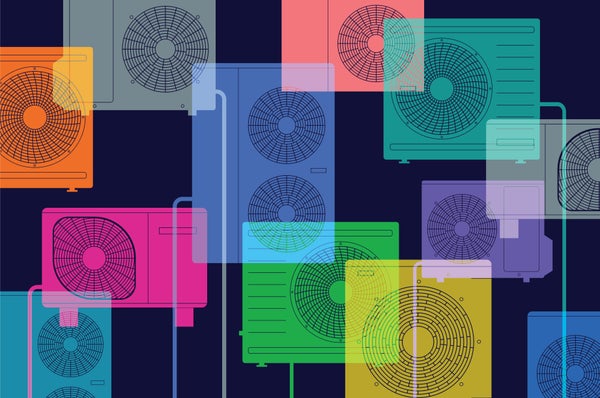November 24, 2023
3 min read
Heat pumps are ubiquitous in the form of air conditioners. Scientists just invented one that avoids harmful refrigerant gases
Air conditioners around the world compress and vaporize environmentally damaging gases to cool and heat air. But a new heat pump technology could change all that.
The use of environmentally damaging gases in air conditioners and refrigerators could become redundant if a new kind of heat pump lives up to its promise. A prototype, described in a study published last week in Science, uses electric fields and a special ceramic instead of alternately vaporizing a refrigerant fluid and condensing it with a compressor to warm or cool air.
The technology combines a number of existing techniques and has “superlative performance,” says Neil Mathur, a materials scientist at the University of Cambridge, UK.
Emmanuel Defay, a materials scientist at the Luxembourg Institute of Science and Technology in Belvaux, and his collaborators built their experimental device out of a ceramic with a strong electrocaloric effect. Materials that exhibit this effect heat up when exposed to electric fields.
In an electrocaloric material, the atoms have an electric polarization — a slight imbalance in their distribution of electrons, which gives these atoms a ‘plus’ and a ‘minus’ pole.
When the material is left alone, the polarization of these atoms continuously swivels around in random directions. But when the material is exposed to an electric field, all the electrostatic poles suddenly align, like hair combed in one direction. This transition from disorder to order means that the electrons’ entropy — physicists’ way of measuring disorder — suddenly drops, Defay explains.
But the laws of thermodynamics say that the total entropy of a system can never decline, so if it falls somewhere it must increase somewhere else. “The only possibility for the material to get rid of this extra mess is to pour it into the lattice” of its crystal structure,” he says. That extra disorder means that the atoms themselves start vibrating faster, resulting in a rise in temperature.
The researchers then remove the heat by flowing a fluid between slabs of the electrocaloric material, while keeping the electric field on. The result is that the slab goes back to the original, ambient temperature, but has a lower polarization entropy. If the researchers then switch off the electric field, it produces the reverse effect: the polarizations become chaotic again, and entropy pours out of the atomic lattice of the ceramic, carrying heat away with it. The result is that the lattice becomes colder than the ambient temperature and it can cool fluid pumped between the slabs. The cycle then starts again.
In a refrigerator or air conditioner, heat from the warmed-up fluid would be dispersed in the environment, while the cooled fluid would serve to keep the interior or the room cold. For heating, the heat pump would cool down the external environment, extracting heat from it to be pumped into the building.
Defay says that although the technology is not yet ready to be commercialized, with further refinements, the efficiency of his team’s electrocaloric heat pump could be competitive with that of existing heat pumps. That’s a tough standard to meet, because heat pumps based on compressors are already very efficient: when used for heating buildings, for example, they can yield three or more times as much heat as space heaters do, for the same amount of electricity consumption. But unlike a standard heat pump, an electrocaloric heat pump would not need refrigerants such as hydrofluorocarbons or ammonia, which are potentially harmful to the environment. And because it removes the need for a compressor, it could potentially fit into a smaller, simpler device, Defay adds.
This article is reproduced with permission and was first published on November 20, 2023.




